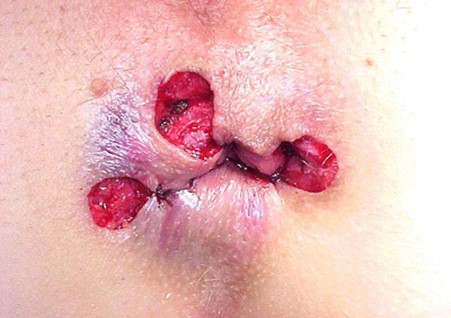Piles
Internal & External
PILES is loss of elasticity of veins in the anal canal & lowermost part of rectum. It in seen in both the sexes. The chances of occurance increase with the age. Piles are classified as
- Internal piles ( arising in the upper two-thirds of anal canal )
- External piles ( it is skin covered lower one-third of the canal or at anal opening) Intenal piles occurs due to obstruction in venous return from that part. Causes can be Hereditary, anatomical , physiological factors,constipation, diarrhea straining at stool, Inadequate fibre diet etc.
Grade 1
Painless Bleeding
Anal Discomfort
Pile may protrude while straining but not prolapsing
Grade 2
Painless Bleeding
Discharge, Itching
Prolapse visible at straining but spontaneously return to normal place when straining ends.
Grade 3
Painless Bleeding
Discharge, Itching
Prolapse has to be reduced manually.
Grade 4
Bleeding pain
Discharge, Itching
The piles always remain prolapsed.

Treatment of Piles
Rubber band ligation
A ligation instrument is inserted through a speculum to grasp or suction the targeted haemorrhoid to facilitate placement of a rubber band over the haemorrhoid down to its pedicle. The haemorrhoid ischemically necroses, and a virtual mucopexy occurs as the anal mucosa is pulled upward and the necrotic base puckers mucosa together, effectively elevating the more inferior anal mucosa
Treatment of Piles
Stapled haemorrhoidopexy
In this procedure, mucosal tissue 4 cm proximal to the dentate line is circumferentially removed and stapled so that the distal hemorrhoidal columns are effectively lifted back above the anal verge and attached to each other (mucopexy).
Treatment of Piles
Haemorrhoidal artery ligation
It is also known as transanal hemorrhoidal dearterialization, is a promising emerging therapy for grade II or III haemorrhoids. In this procedure, the superficial artery directly proximal to the associated haemorrhoid is isolated and ligated. Specialized lighted anal speculums with or without Doppler probes and/or suture ports have been developed to assist with this technique. This can be performed with or without mucopexy.
Treatment of Piles
Closed Haemorrhoidectomy
It involves excising the hemorrhoidal bundles using a sharp instrument, like a scalpel. It is then followed by complete wound closure with an absorbable suture.
Treatment of Piles
Open haemorrhoidectomy
In this procedure, haemorrhoidal tissue is excised like in a closed haemorrhoidectomy procedure, but the incision is left open.
Treatment of Piles
Laser Haemorrhoidectomy
During a Laser Piles Surgery, laser beams are delivered directly to the hemorrhoids, in order to shrink them. Hemorrhoids have increased blood supply that essentially prevents shrinkage. The energy, which is directly delivered to the sub-mucosal hemorrhoidal nodes reduce the blood supply to the hemorrhoids and subsequently shrink them.
Treatment of Piles
IRC
IRC involves the use of infrared light as a heat source to quickly coagulate, or clot, vessels supplying blood to the haemorrhoids. A small probe is used to painlessly deliver a few short bursts of infrared light to the haemorrhoids. The infrared coagulation causes the enlarged hemorrhoidal tissue to shrink and recede.
Treatment of Piles
Cryosurgery
- Over 20 yrs.
- Freezing of Haemorrhoids.
- CO2 or Nitrous cylinder, Cryo gun with probe.
- Applied for 2 min. creating an Ice ball, separated gently.
- Complication: Pain and Discharge.
- Takes 4 to 8 weeks.
Treatment of Piles
Sclerotherapy
- John Morgan-1869, 1st attempt
- Method: Injection of sclerosing agent in the sub-mucosal plane, around the site of Internal hemorrhoids
- Mechanism of action: Scarring and Fibrosis
- Solutions: Phenol, Carbolic acid, quinine and Urea hydrochloride, Sodium morrhuate, STD, glycerine, vegetable oils.









